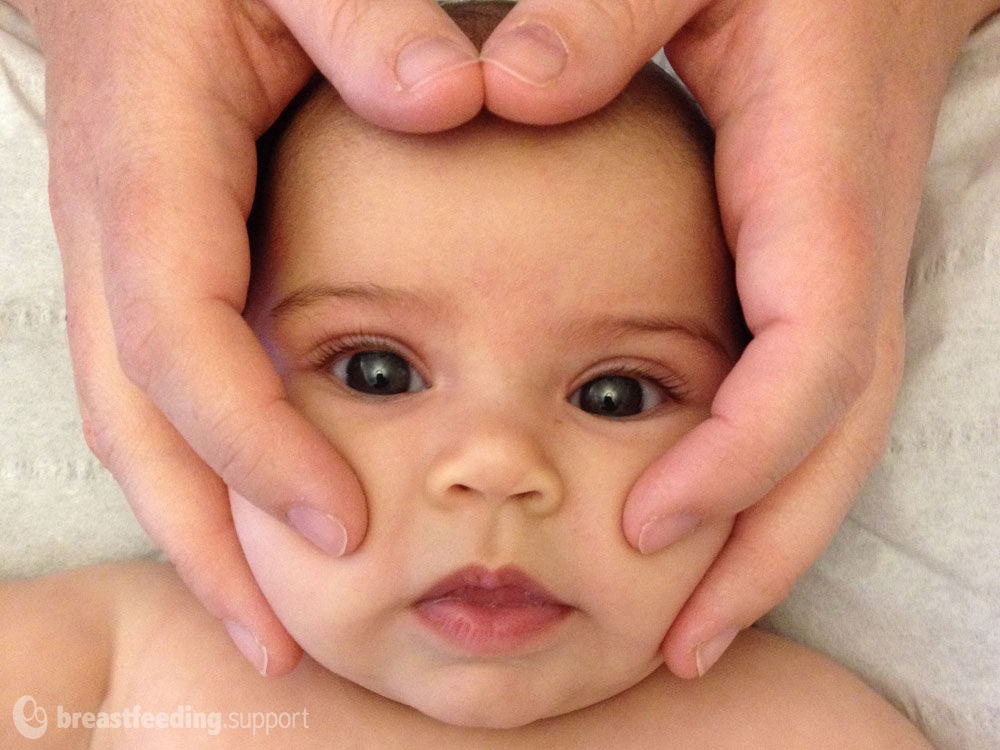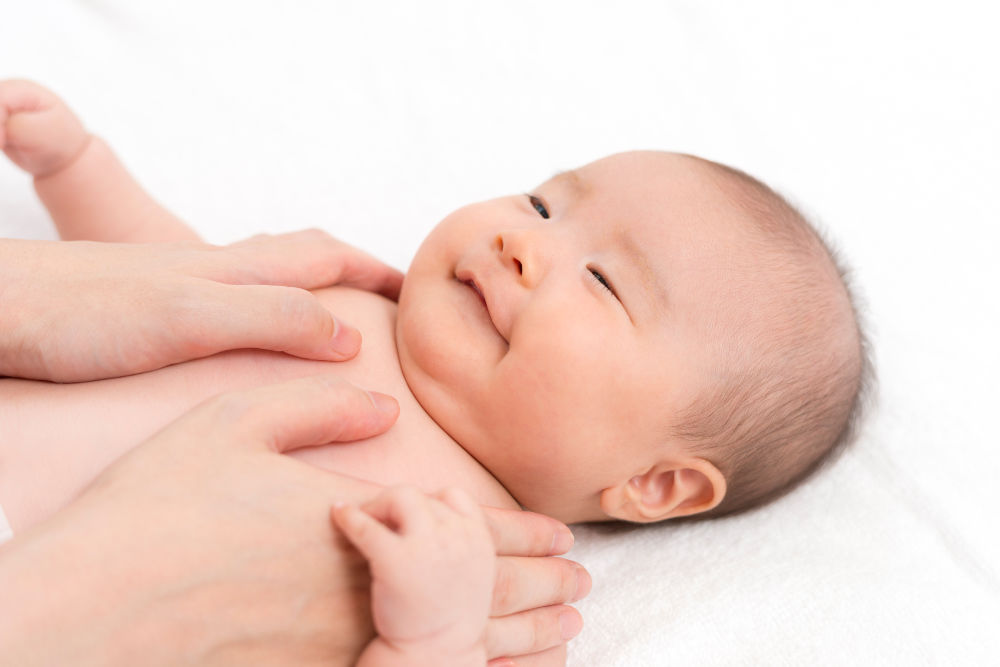Some breastfeeding resources and breastfeeding advocates favour cranial work or ‘hands-on’ therapies as a way to help certain sucking problems in a breastfed baby. See Does Cranial Therapy Work? for a review of how these therapies may help. Cranial osteopathy and craniosacral therapy are two possible cranial treatments said to be helpful alongside other forms of physical therapy. This article compares the differences between cranial osteopathy and craniosacral therapy and considers whether there is any research to guide how these therapies can help breastfeeding.
Experience is key
Dee Kassing IBCLC suggests that any of several physical therapies may be useful but finding a therapist who is very experienced working with babies is the key.
In recent years, there have been frequent references to CranioSacral Therapy and other bodywork for infants who are having difficulty breastfeeding.
Any of the methods might be helpful to a baby. When choosing a therapist, who could be a certified massage therapist, a physical therapist, a chiropractor, an osteopath, etc., be sure to ask how much training and experience in working with infants the therapist has had.
Some chiropractors are also accredited in pediatric chiropractic. This is a different type of bodywork, but can also be very helpful to infants. Adult chiropractic applied to babies would be dangerous, so again it is necessary to ask about the chiropractor’s training and experience.

Cranial osteopathy or craniosacral therapy for my baby?
Cranial osteopathy is a specialised form of osteopathy that is used throughout the body not just the head. Craniosacral therapy stems from cranial osteopathy but works on the ‘craniosacral system’. The craniosacral system is said to comprise of the membranes and fluids that surround the brain and spinal cord. The professional associations for cranial osteopathy and craniosacral therapy are named after their developers Dr William Sutherland and Dr John Upledger respectively and excerpts from their websites say the following:
Cranial osteopathy is not different to osteopathy, it is the name given to a subtle and refined approach to osteopathy that follows all the principles of osteopathy, but that includes the anatomy and physiology of the head.
Cranial osteopaths use a highly trained sense of touch to feel subtle changes of tension and tissue quality in the living anatomy of the whole body, and to diagnose areas of strain or dysfunction.
CranioSacral Therapy (CST) is a gentle, hands-on method of evaluating and enhancing the functioning of a physiological body system called the craniosacral system – comprised of the membranes and cerebrospinal fluid that surround and protect the brain and spinal cord. Using a soft touch generally no greater than 5 grams, or about the weight of a nickel, practitioners release restrictions in the craniosacral system, which has been shown to improve the functioning of the central nervous system, as well as many other systems of the body, such as digestive, musculoskeletal, respiratory, circulatory, and more.

Training requirements for therapists
A cranial osteopath has to qualify as an osteopath first whereas a craniosacral therapist may not be an osteopath.
- A cranial osteopath will train for a four year full time or five year part time degree to initially become an osteopath then post graduate training to become a cranial osteopath. Post graduate training for the cranial osteopathic approach is through the Sutherland Cranial College of Osteopathy (SCCO). A member will have completed two or more modules, a fellow will have completed all of the modules.
- Craniosacral therapist training is a one or two year part time diploma
When might these therapies be helpful to babies?
A baby’s skull comprises bony plates held together by flexible joints (sutures). The bones in the infant skull need to move over each other to allow for squeezing down the birth canal. After birth, yawning, sucking and crying help to move the cranial bones back into position and the bones will fuse (become fixed) later over time. Sometimes however, yawning, sucking and crying may not completely put everything back in place, perhaps the birth was very traumatic or forceps or ventouse (vacuum assisted vaginal delivery) were used. If any of the skull bones are not aligned correctly this could affect the way a baby can use his mouth, jaw and tongue to latch (attach to the breast) and suckle correctly. If the skull and connective tissues are unbalanced a baby may feel uncomfortable and tense, this is when physical therapies may be useful to free any tension (Kassing, 2014).
For further discussion of how cranial work or other bodywork is thought to help in these situations, see Does Cranial Therapy Work?
Are cranial therapies safe for my baby?
There are not many good quality studies looking specifically at how cranial therapies might help with the mechanics of breastfeeding nor their safety. Herzhaft-Le Roy et al attempted to assess the efficiency of osteopathic treatment on a baby’s latch alongside lactation consultant care.1 The study concluded a single osteopathic treatment combined with a lactation consultation could reduce biomechanical sucking difficulties in babies under six weeks of age although there was no significant difference in nipple pain between the control and treatment groups. Some articles question the lack of an evidence base behind cranial techniques.23 An article in Chiropractic & Osteopathy 2010 by Kim Humphreys calls for more research on children’s therapies:
Conclusions
There is currently insufficient research evidence related to adverse events and manual therapy. However, clinical studies and systematic reviews from adult patients undergoing manual therapy, particularly spinal manipulation report that mild to moderate adverse events are common and self limiting. However serious adverse events are rare and much less than for medication commonly prescribed for these problems. More high quality research specifically addressing adverse events and pediatric manual therapy is needed.
If you are considering trying a physical therapy it is important to find a fully qualified, reputable practitioner who has been recommended to you, is a member of their professional association and is very experienced working with breastfed babies.
Summary
Cranial therapists and some tongue tie practitioners often claim that cranial therapies can help with a baby’s tongue function or other physical issues such as opening the jaw widely to attach to the breast. Although there is very little scientific evidence supporting the use of cranial techniques, many parents have felt these therapies were helpful for their baby. Training requirements for cranial osteopathy are longer than for craniosacral therapy. It is important to choose a specialist who is experienced working with babies and comes with recommendations and references. There can be many causes and solutions of breastfeeding difficulties and most will not require physical therapy—for a thorough breastfeeding assessment contact an IBCLC lactation consultant and if you have any concerns about your baby’s physical health contact your doctor for advice.